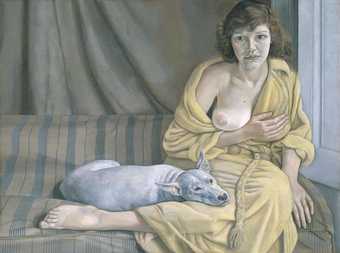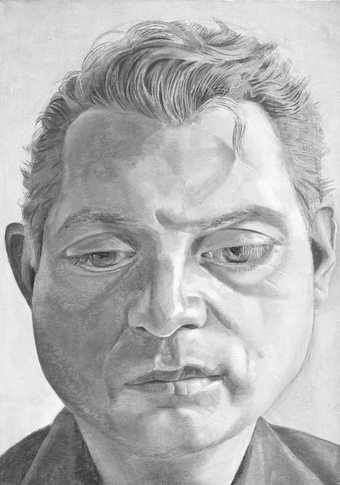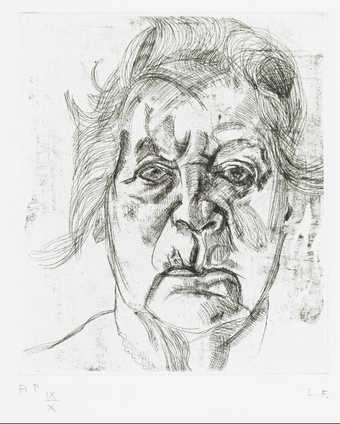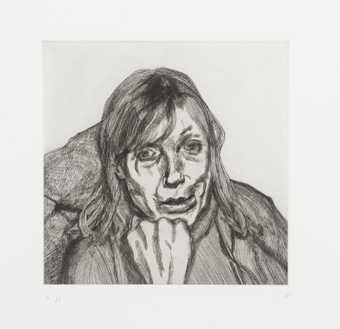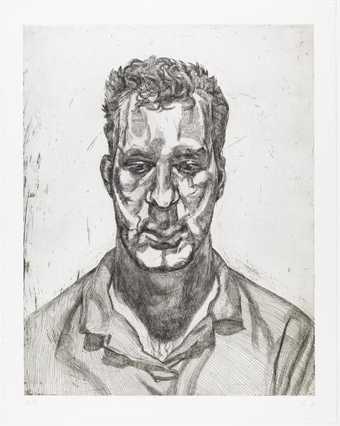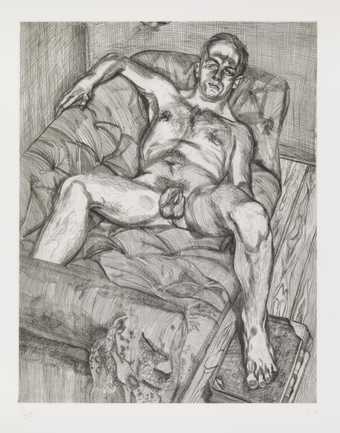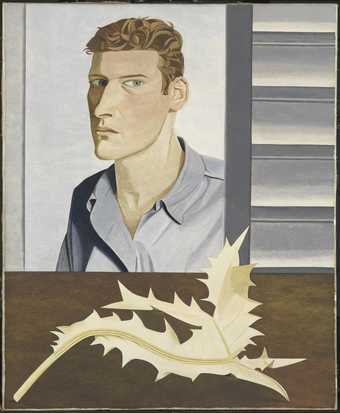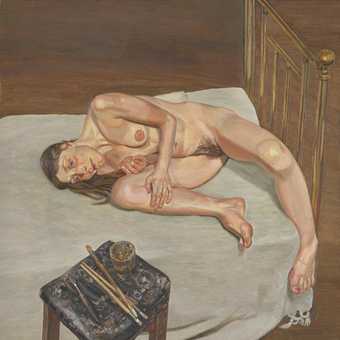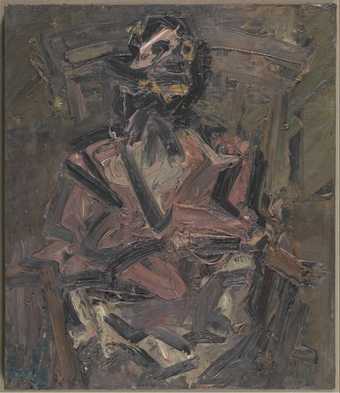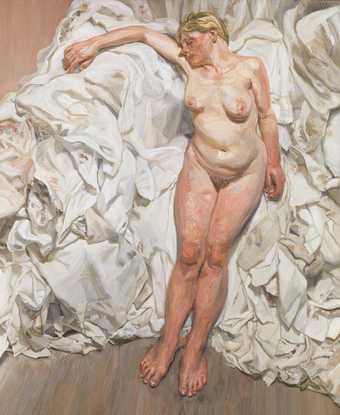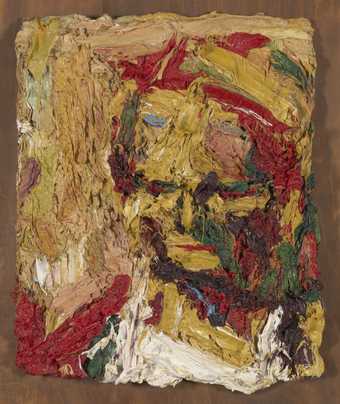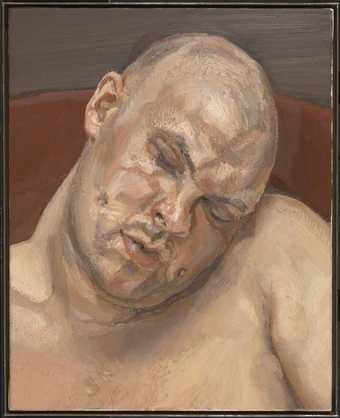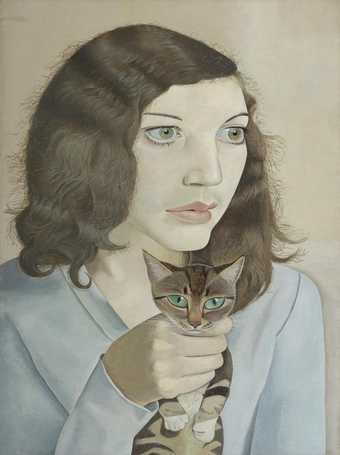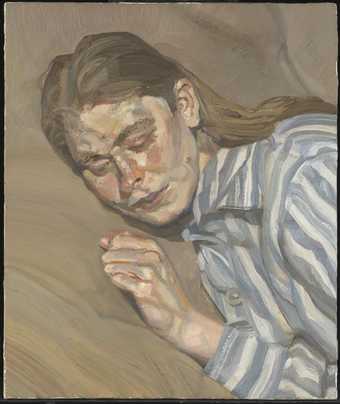
Not on display
- Artist
- Lucian Freud 1922–2011
- Medium
- Oil paint on canvas
- Dimensions
- Support: 273 × 186 × 16 mm
frame: 350 × 264 × 35 mm - Collection
- Tate
- Acquisition
- Bequeathed by Simon Sainsbury 2006, accessioned 2008
- Reference
- T12619
Summary
The Painter’s Mother IV 1973 is a small painting by the British artist Lucian Freud depicting the head and shoulders of an older woman set against a dark brown and grey background. It was painted from a vantage point that is slightly above and to the right of the sitter, whose face occupies the centre of the image. Her eyes are cast downward and her face is fleshy and puckered, an effect achieved through the use of grey paint to mark out shadows across the skin. She wears a brown garment with folds around the neck and shoulder areas, and her hair, which is white with red-brown and grey tones, is combed back from her face and appears to be gathered loosely behind her head. The surface of the painting shows a variety of different textures: the paint in the grey area in the background, which may represent a wall, is smooth and evenly applied, whereas the more detailed areas of the painting, such as the woman’s face and clothing, are rendered in thick impasto.
The Painter’s Mother IV is one of a series of eighteen portraits of the artist’s mother, Lucie Freud, that he made in his studio in Thorngate Road in Maida Vale, London, between 1972 and 1984. The series includes ten paintings, five drawings and three etchings, and Lucie sat more than one thousand times for the portraits over the course of a decade, with the sittings lasting between four and eight hours and each portrait taking several months to complete. To make The Painter’s Mother IV, Freud first applied two layers of white primer to the canvas to ensure that the surface was almost entirely smooth before colour was added. Freud then applied the paint using a hogshair brush, and in several places achieved the depth of texture in the painting by applying raw pigment directly to the canvas – for instance, red lake and viridian green were used to underpin the flesh tones and the browns of the sitter’s clothes. Detail was also achieved by using the brush to take paint off the surface as well as to apply it: the fine fibres of the woman’s jumper were created by adding several layers of successively darker paint to the canvas and using a small stiff hogshair brush to expose the lighter coloured parts beneath.
Freud began to produce the portraits of his mother shortly after the death of his father, Ernst Freud (1892–1970). After Ernst’s death Lucie suffered from depression, from which she never recovered, and which at one point led her to attempt suicide. The curator Andrew Wilson has suggested that Freud used the series as a way of ‘combatting her depression’ (Wilson 2008, p.116), and her grief is reflected in portraits such as The Painter’s Mother IV in the muted grey and brown palette and Lucie’s melancholic expression. The paintings in the series bear the same textured surfaces and psychological detail seen in Freud’s later full-length portraits, such as Leigh Bowery (Seated) 1990 (private collection) and Benefits Supervisor Sleeping 1995 (private collection), though in the case of The Painter’s Mother portraits, the scale is far more intimate.
There are many famous paintings by artists of their mothers that present the sitter in a sensitive way as an elderly but calm and strong figure, for example John Opie’s The Artist’s Mother c.1791 (Tate N03518), James Abbott McNeill Whistler’s Portrait of the Artist’s Mother 1871 (Musée d’Orsay, Paris), Vincent Van Gogh’s Portrait of the Artist’s Mother 1888 (Norton Simon Museum of Art, Pasadena, California) and David Hockney’s Portrait of the Artist’s Mother 1972 (Tate T11897). The Painter’s Mother IV was first exhibited as part of a retrospective of Freud’s work at the Hayward Gallery in London in 1974, and then again in 1978 in the exhibition Lucian Freud: Recent Paintings at the Anthony d’Offay Gallery, London. Shortly after this it entered the private collection of the philanthropist Simon Sainsbury (1930–2006), who gifted the painting to Tate in 2006 along with several other works by Freud, including Girl with a Kitten 1947 (Tate T12617) and Boy Smoking 1950 (Tate T12618).
Further reading
Andrew Wilson (ed.), The Simon Sainsbury Bequest to Tate and the National Gallery, exhibition catalogue, Tate Britain, London 2008, reproduced p.18.
Sarah Howgate, Michael Auping and John Richardson, Lucian Freud: Portraits, exhibition catalogue, National Portrait Gallery, London 2012.
Judith Wilkinson
October 2014
Supported by Christie’s.
Does this text contain inaccurate information or language that you feel we should improve or change? We would like to hear from you.
Explore
- people(22,072)
-
- actions: postures and motions(9,111)
-
- looking down(200)
- adults(20,120)
-
- woman, old(265)
- body(4,878)
-
- head / face(2,497)
- named individuals(12,887)
-
- Freud(2)
- portraits(4,491)
-
- individuals: female(1,698)
You might like
-
Lucian Freud Girl with a White Dog
1951–1952 -
Lucian Freud Francis Bacon
1952 -
Lucian Freud Head of a Woman
1982 -
Lucian Freud The Painter’s Mother
1982 -
Lucian Freud Head of a Woman
1996 -
Lucian Freud Kai
1992 -
Lucian Freud Man Posing
1985 -
Lucian Freud Man with a Thistle (Self-Portrait)
1946 -
Lucian Freud Naked Portrait
1972–3 -
Frank Auerbach J.Y.M. Seated No. 1
1981 -
Lucian Freud Standing by the Rags
1988–9 -
Frank Auerbach Head of E.O.W. I
1960 -
Lucian Freud Leigh Bowery
1991 -
Lucian Freud Girl with a Kitten
1947 -
Lucian Freud Girl in a Striped Nightshirt
1983–5

